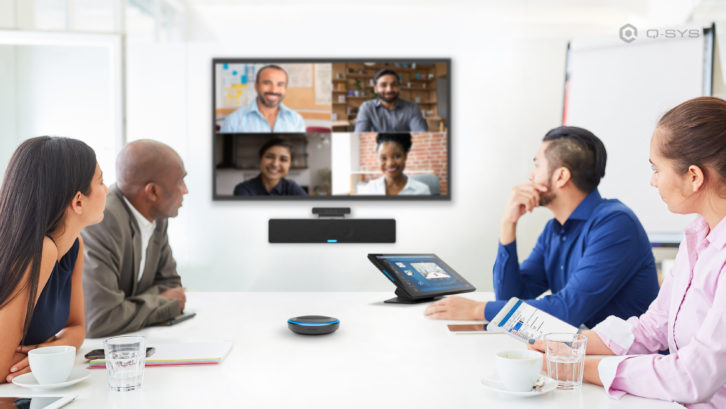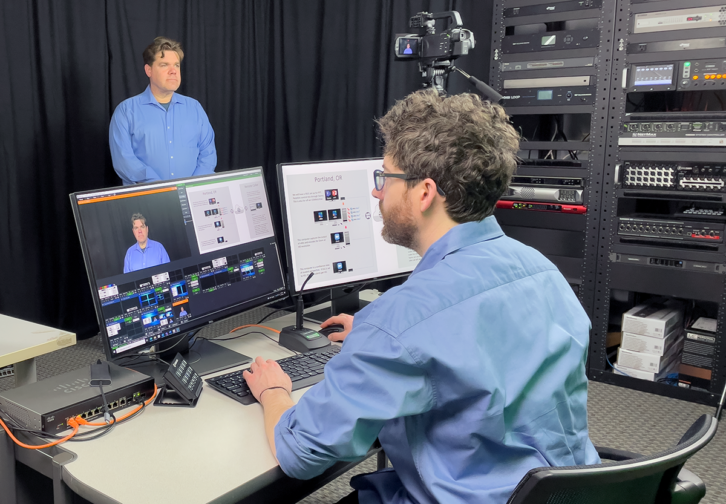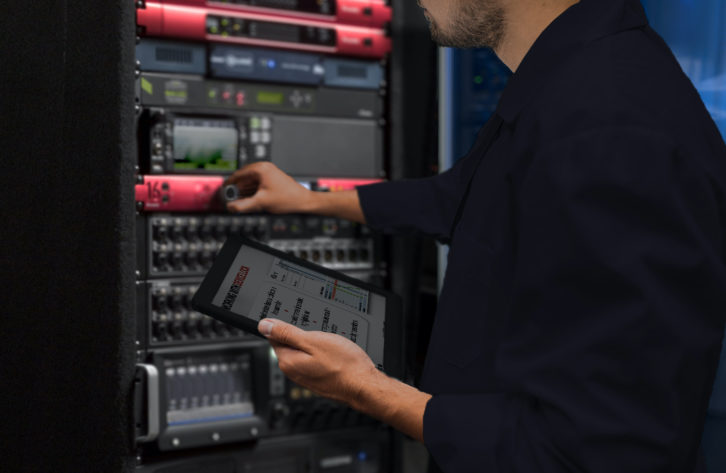Networked sound as a generic, umbrella term is easy to understand, both in terms of practicality and basic technology. This is because having a wide variety of audio devices working together on a single infrastructure, which can be within a building, linking several locations or connecting different countries, makes sense in these days of large-scale installations and productions, particularly when broadcast and video streaming is factored into the equation.
Similarly, the utilisation of audio over IP (AoIP) and audio over Ethernet (AoE) to facilitate the creation of these networks is also generally understood, if only because the general influence of IT on most areas of modern life – from home computing to business to AV production – is now so firmly established. What is perhaps less easy to comprehend is that there is not a universal network standard covering all requirements.
While it might seem the current array of AoIP protocols is a continuation of the format wars that have long plagued the professional sound technology sector, the lack of a “one size fits all” solution reflects the reality of different productions and applications having differing needs, which would not be best served by using just one protocol for audio transport and control.
INDUSTRY BODIES
Among the industry bodies to have acknowledged this is the Avnu Alliance, a consortium of manufacturers and other developers working on interoperable infrastructures for reliable, low-latency, time-synchronised networking of devices based on the open IEEE Time-Sensitive Networking (TSN) standard. The first product of this work was AVB (audio video bridging), which, ten years ago, was regarded as a contender to be the audio and video networking protocol of choice for live sound and AV installation.

Even though many companies became participants in the Avnu Alliance and major manufacturers, including L-Acoustics, d&b audiotechnik and Meyer Sound, adopted AVB, the market perception was that, as far as AoIP was concerned, it was becoming marginalised and falling behind Dante and RAVENNA. AVB did not go away, however, and now provides the basis for the Milan pro AV networking protocol, which also features deterministic TSN technology.
The Avnu Alliance states that it is focused on ‘converged networking’, which it sees as “an urgent demand for most installation projects”. This is because it will allow different protocols, each suited to a specific function or discipline, to coexist reliably on a single network. The deterministic nature of TSN gives network designers the freedom to easily build and configure systems that can carry different data and protocol formats with full reliability. While this is the aim, the Alliance does acknowledge that how this can be done and what the components will be still need to be worked out.
TECHNICAL MEANS
A key element of convergence is interoperability, which provides the technical means for otherwise incompatible technologies to connect and work in conjunction with each other. A major step towards this for AoIP was made in 2013 when the Audio Engineering Society (AES) published AES67. This interoperability standard made it possible for different AoIP protocols to run on the same network and has gone on to be part of the SMPTE ST 2110 standard for transmitting digital media over IP networks (as ST 2110-30). Both Dante and RAVENNA incorporate AES67, which has given these formats a wider reach and made for more converged networking.
Josh Rush, chief marketing officer of Dante developer Audinate, comments that the company’s own market research shows “it all comes back to one thing – interoperability.” This is, he explains, because “customers are looking for video, audio and control solutions that are integrated.” To provide this, Audinate has produced Dante AV, which combines video and audio “accessibility and usability” with IT management and control, low latency and timing, all with full interoperability.
“Audio networking technology is no longer just ‘nice to have’ within the industry but is now a ‘must have’,” Rush adds. “It has allowed for the democratisation of the AV market in a way that has made the enabling technology more manageable, affordable and functional, becoming the standard for high quality installations in almost all verticals. As computers and networking continues their path towards ubiquity along many fronts, legacy non-networked audio products run the very real risk of simple obsolescence. An investment in network infrastructure is a sure way to avoid that dilemma for both customers and end-users of audio systems by smartly ‘future-proofing’ installations. Steering customers and end-users toward networking prepares them and their facilities fro a world of new possibilities, stretching for many years to come.”
NETWORK STANDARD
Because of the very particular needs professional AV has in terms of networking, including connectivity and control, the Alliance for Interoperable Media Systems (AIMS), Video Services Forum (VSF) and Advanced Media Workflow Association (AMWA) have been working together to produce a network standard that is specific to the sector. In doing this, the three organisations have adapted AES67, ST 2110 and AMWA NMOS (Networked Media Open Specifications for system management and control) to produce IPMX (IP-based Media Experience), which is more tailored towards pro AV.
“While all the proprietary solutions are still being evolved by their respective technology owners, IPMX offers the chance to manufacturers and system integrators to build media networks on true open standards,” explains Andreas Hildebrand, senior product manager of RAVENNA developer ALC NetworX, which is a member of AIMS. “The first IPMX-enabled products have already entered the market and interoperability demonstrations run by AIMS are a highlight at shows like ISE and InfoComm. One can expect that providers of proprietary solutions will follow this trend and adopt IPMX in their technologies.”

Hildebrand adds that all the competing – and proprietary – formats “have their individual advantages and disadvantages”, which could make them better suited to one or other possible applications. “In the end, the question of which networking technology is better supported by those devices most suitable for a particular project becomes a decisive factor, which in turn also limits the choice of devices that can be used in a particular project,” he says.
Marcus Rembold, product manager for DSP and audio networks at d&b audiotechnik, observes that “more and more AV products are already talking IP in one way or another”, with Dante as the “de facto standard”. However, in the medium to long-term, he does see a shift to cross-platform, open and interoperable network standards: “With TSN and AVB/Milan, silicon manufacturers are directly involved in the specification of the standard, resulting in a variety of options rather than a one-size-fits-all solution.” He adds that the current problems in the supply of components and equipment in general show “the risks of a solution with only one supplier.”
Rembold continues that a standard such as Milan can “create the technological prerequisite for a seamless workflow”, running from planning and simulation through control and operation of an AV system to signal processing, distribution and playback. “To achieve this, AV network protocols must be able to support the important trend and new market requirement of data convergence,” he says. “In many cases, modern system solutions designed to provide an elegant and streamlined workflow benefit from the ability to enable multiple protocols such as audio, video, control and other traffic on the same network infrastructure. We see great potential in Milan to make life easier here due to its deterministic behaviour, predictability and technological advantages such as bandwidth reservation, especially in redundant setups.”
While the various AoIP protocols are often presented as rivals or being in competition, Rembold does not see this as being the case. “From our point of view, the network formats do not necessarily compete with each other,” he explains. “Having different options to choose from is an advantage for the customer and user. We can offer both Dante and Milan-based solutions in the future and it is best to select the most appropriate protocol for the application at hand.”
OPEN PLATFORMS
The greater integration of different networking systems through interoperable technologies has allowed for what could be termed ‘proprietary open platforms’. Developed by a single manufacturer with input and support from other companies, these are able to integrate over a wider network due to interconnectivity with both compliant third party devices and AES67. An example of this is Q-SYS, a cloud-manageable, IT-based audio, video and control platform developed by amplifier and loudspeaker manufacturer QSC. It is able to integrate with products made by partner companies, including Sennheiser, Panasonic, Cisco, Google, Barco and Audinate; through Dante it is able to work with AES67.

“It is hard to place a single protocol or platform as the leader within the AoIP world, but it would be fair to say Dante/AES67 does seem to be the current standard that manufacturers base products around,” comments Rob Sherry, senior sales manager for QSC in the UK and Ireland. “In the past, many AoIP products required specific pieces of hardware to enable communication. This has presented some challenges within the last few years with limited silicon supply causing significant product shortages. What we have seen [now], however, is manufacturers pivoting to software-based deployments of these technologies. The advantages of this are in the supply chain, the scalable licensing model that reduces system cost by purchasing only the functionality required and advancements in power over Ethernet loudspeakers.”
Even with the considerable movement towards more open networking through greater interoperability, there is still the thought that the goal still has not been fully achieved. “Despite the great developments in AV technology recently, there is significant development work needed before open IP networking becomes mainstream,” comments Siamäk Naghian, managing director of Genelec. “There are many different, well-established solutions that have been developed over a long period. However, the key problem is that they are closed networking technologies, based on proprietary solutions. Therefore they have lagged behind open standards like IP. AV has a particular requirement when it comes to latency and bandwidth capacity, which has helped keep AV systems dedicated and closed. But advanced networking and computing technologies, along with digitalisation, now provide a great foundation to tackle the requirements of AV.”
Technological advances, both in terms of capabilities and system volume (bandwidth, storage, transfer rates), are, says Naghian, increasing the possibilities for open infrastructures, low latency, higher capacity and a high degree of compatibility. Whether fully open networking is technically obtainable remains to be seen. While the logical conclusion is that, given ongoing development and innovation, it is likely it will be, there is still the question of how desirable or even necessary it could be. Ultimately, it will be the needs of the end-user and the project that will decide.